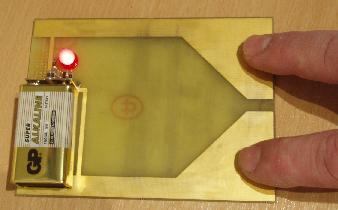|
|
|
|
|
|
|
|
ERIC is very sensitive and will light the LED, perhaps quite dimly, with very small currents. People conduct electricity and, typically, if you press fingers against both contacts, you will light the LED.

The current flow from the 9 volt battery is so small that there will normally be no sensation caused.
If you have just washed and dried your hands very thoroughly, or you have very dry skin, you may not be able to light the LED. You can improve the contact by wetting your fingers.
There are plenty of experiments to do with this. For example, if you start with one finger on each contact, you can try touching one of the contacts with an extra finger or using two fingers on each contact. This will increase the brightness as it decreases the resistance.
You can try using two people. If each person has one finger on each contact, the resistance is reduced and the LED will be brighter. This is called a PARALLEL circuit. Each circuit passes its own current and the LED shows the sum of the currents.
If one person puts a finger on a contact and another person puts a finger on the other contact but the two people don't touch one another, there is no circuit and the LED will not light. If the people then hold each other's spare hand, the circuit will be completed by this and the LED will light. The current passes through one person from finger to hand and then through the other person from hand to finger. The LED will be dimmer than if either had connected themselves individually across the contacts. This is called a SERIES circuit.
With lots of people, you can try all of them in parallel. This can get very crowded as each one tries to touch both contacts. This will give maximum brightness.
You can try all the people in series, forming a chain across the contacts. The LED may be very dim if you have enough people. You may have to shade the LED to see it. If any part of the chain is broken the LED will go out. You may be able to make the LED light with the whole class.
Skin conducts electricity better if it is wet. You can try the experiment by putting your fingers across the contacts and seeing how bright the LED is and then repeating after you have licked them. You can make the LED light with more people in series if they have wet hands.
Electricity can be dangerous. ERIC uses a low-voltage battery and you will not damage yourself using it. However, you should be aware that these experiments are quite fun and may give the wrong impression to young children. Trying to repeat these experiments with mains electricity and mains light bulbs will probably be FATAL.
You must emphasise to children that electricity can be dangerous. It is difficult to give a direct experience to show that danger without exposing children to hazard. There is a way that I like but cannot recommend as it has health and safety implications. This is to lick the terminals of a 9 volt battery. The direct sensation of electrical shock is quite unpleasant but it is entirely in the control of the child. You would need to try it yourself before suggesting it. You may find that the children try it out themselves.
This electrical shock will cause no permanent damage. The possibility of cutting the tongue or, probably more significant, passing disease from child to child would have to be considered in your risk analysis.
There are "toys" on the market whose function is to deliver an unpleasant electrical shock. These could be used to demonstrate how dangerous electricity can be.
The experiments with wet hands demonstrate that water causes electricity to be more dangerous. This is a good message to pass across.


